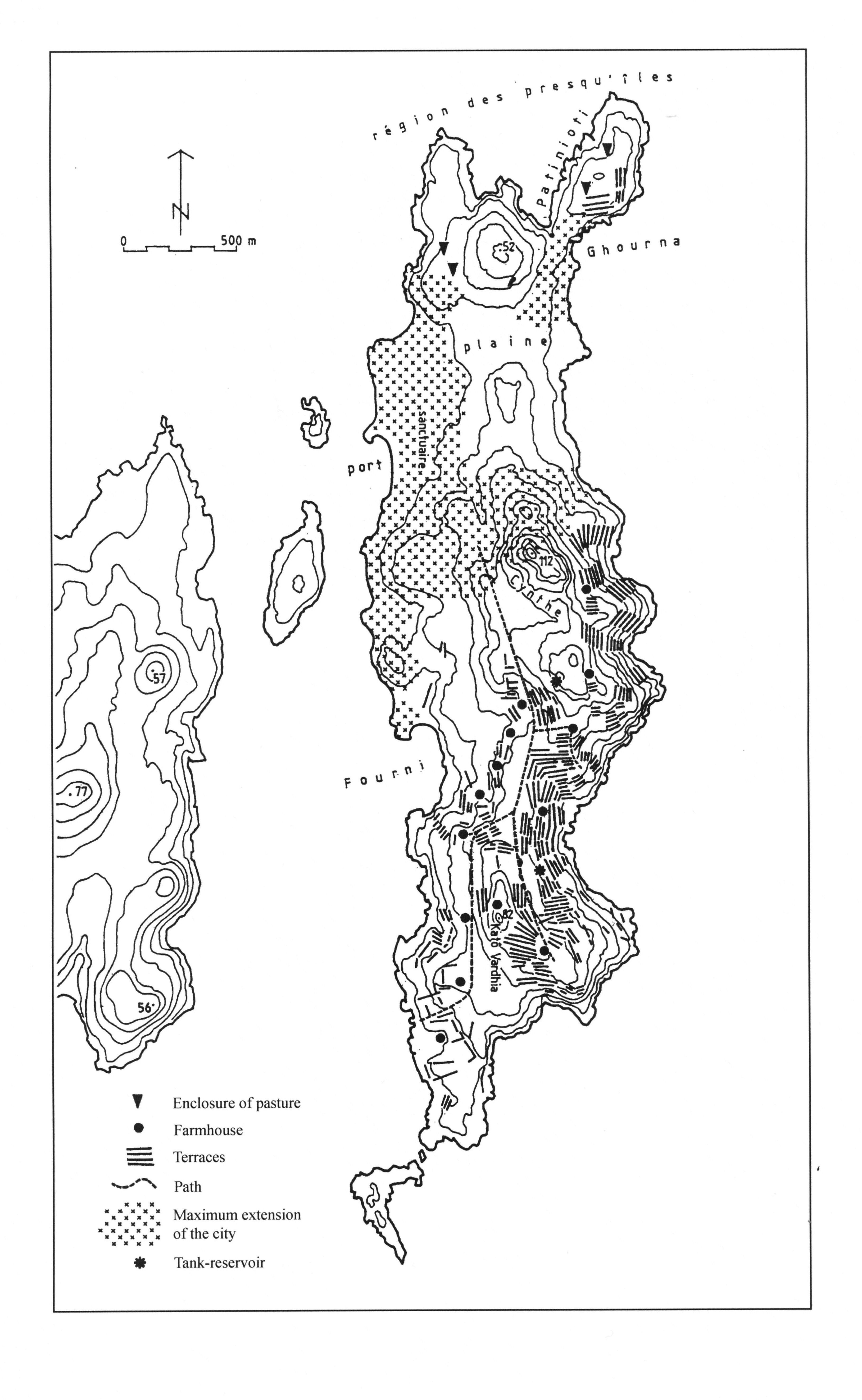Kitchen and Commercial Gardens
Province
Location
Location Description
Delos is a small island in the center of the Cyclades measuring about five kilometers north-south and 1.3 kilometers east-west at the widest. In antiquity, it was famous as the birthplace of Apollo. Apollo’s sanctuary, founded in the seventh century B.C., is situated on a small plain next to the main port. It became a principal Panhellenic cult center and always formed the heart of the later settlement and city. The city was under Athenian supremacy in the fifth and fourth centuries B.C. and became independent only in 314 B.C. Although extensive public building occurred during the period of its status as an independent city-state and the island began to develop as a commercial center, the city remained relatively small and was still mainly engaged in local and regional trade with the surrounding Cycladic islands. This changed significantly when the Romans handed control of Delos to Athens in 167 B.C. and declared it a free port. It soon developed into a booming cosmopolitan trade center with merchants coming from all over the Mediterranean world. As a consequence the city grew considerably, mostly to meet the needs of its new purpose. Squares, quays, warehouses, shops, new residential quarters, and clubhouses of foreign associations were constructed, and public buildings and sanctuaries were either renovated and extended or newly built. Although Delos was sacked twice, in 88 B.C. by the troops of Mithridates and 69 B.C. by the pirates under Athenodoros, its desertion during the first century B.C. is predominantly due to the rivalry of increasingly successful Roman ports like Puteoli and Ostia. Life in Delos did not come to an abrupt halt as evidenced by remains of Roman thermae and several Christian basilicas, but it continued on a much smaller scale.
Garden
Kitchen and Commercial Gardens
Keywords
Garden Description
The inscriptions of the sanctuary of Apollo mention nearly 30 kepoi within the period of 433 B.C. to 156/155 B.C., which were either private or belonged to Apollo and were rented or leased. Most of these cannot be localized because they were named after their former owners and with topographical references or surnames unknown today. However, in the years between 167 and 155 B.C., three kepoi were situated near identified buildings: the sanctuary of Leto, the Hippodrome, and the Neorion. A fourth was located near the palaestra, the identification of which among the several palaestra-buildings in Delos is contested. The first three kepoi were located east of the sanctuary of Apollo in a zone which was regarded as specifically humid and fertile because the Inopos, the main watercourse of Delos, was believed to have passed here before emptying into the Bay of Skardhana to the north. However, it has been shown that the Inopos ended south of the sanctuary of Apollo and could therefore never have irrigated the potential garden zone east of Apollo’s sacred precinct.
The kepoi were certainly always located outside the residential quarters and were used as kitchen or commercial gardens. They were identified as terrain for the cultivation of plants that needed irrigation, such as vines, olives, and figs. This terrain had to be enclosed by walls or fences to keep animals out. In contrast to the kepoi, the choria equally mentioned in the inscriptions of the sanctuary of Apollo served for the growing of cereals and stock farming. According to this definition, kepoi could have been laid out either next to farmhouses serving as kitchen gardens or on some of the many cultural terraces which extended far beyond the center of the city to the south, north, and east of the residential zones (Fig. 1). The necessary water supply was provided by wells, reservoirs, and large pools, some of which have been discovered on these terraces. The water was either distributed by hand or through a system of irrigation channels, starting from one of the reservoirs or large pools.
The variety of trees and plants cultivated in ancient Delos is known from the epigraphic evidence. Among the sporadically listed plants are pomegranates, apples, laurel, almonds, palms, vines, figs, and olives. Fig trees, which to this day form the majority of the Delian tree population, appear most often in the inscriptions.
Maps

Fig. 1: Archaeological plan of the island, 1:2500. Drawing by Nicolas Bresch from Brunet 1999, fig. 1.
Dates
5th-2nd century BCE
Bibliography
- P. Bruneau, “Deliaca II: No. 31. Les jardins urbains de Délos,” BCH 103, 1979: 89-99. (Persée).
- P. Bruneau and J. Ducat, Guide de Délos. École française d Athènes. Fourth edition, Paris, 2005, Nos. 75, 128. (worldcat).
- M. Brunet, “Contribution à l’histoire rurale de Délos aux époques classique et hellénistique,” BCH 114, 1990: 669-682. (Persée).
- M.-C. Hellmann, Recherches sur le vocabulaire de l’architecture grecque, d’après les inscriptions de Délos. BEFAR 278, 1992. (worldcat).
- M. Brunet, “La campagne délienne,” in V. Anagnostopoulos, ed., L’espace grec, cent cinquante ans de fouilles de l’École française d’Athènes. Paris 1996: 59-66. (worldcat).
- J.-C. Moretti, “Le gymnase de Délos," BCH 120, 1996: 617-638. (Persée).
- J.-P. Brun and M. Brunet, “Une huilerie du premier siècle avant J.-C. dans le Quartier du théâtre à Délos,” BCH 121, 1997: 573-609. (Persée).
- M. Brunet, “Le paysage agraire de Délos dans l’Antiquité,” Journal des Savants 1999: 1-50. (Persée).
- M. Brunet, et al., “L’eau à Délos: un milieu naturel et son aménagement durant l’Antiquité,” BCH 125, 2001: 620-627. (Persée).
- M. Brunet, “Le courtil et le paradis,” in: J.-P. Brun and P. Jockey, eds., Techniques et sociétés en Méditerranée. Hommage à Marie-Claire Amouretti. Collection L’atelier méditerranéen. Travaux du Centre Camille Jullian, Aix, 2001:157-168. (worldcat).
- C. Prêtre, ed., Nouveau choix d'inscriptions de Délos. Lois, comptes et inventaires. Études épigrapiques 4, 2002. (worldcat).
Pleiades ID
TGN ID
Contributor
Monika Trümper (ORCID: 0000-0003-4524-6242)
Publication date
21 Apr 2021